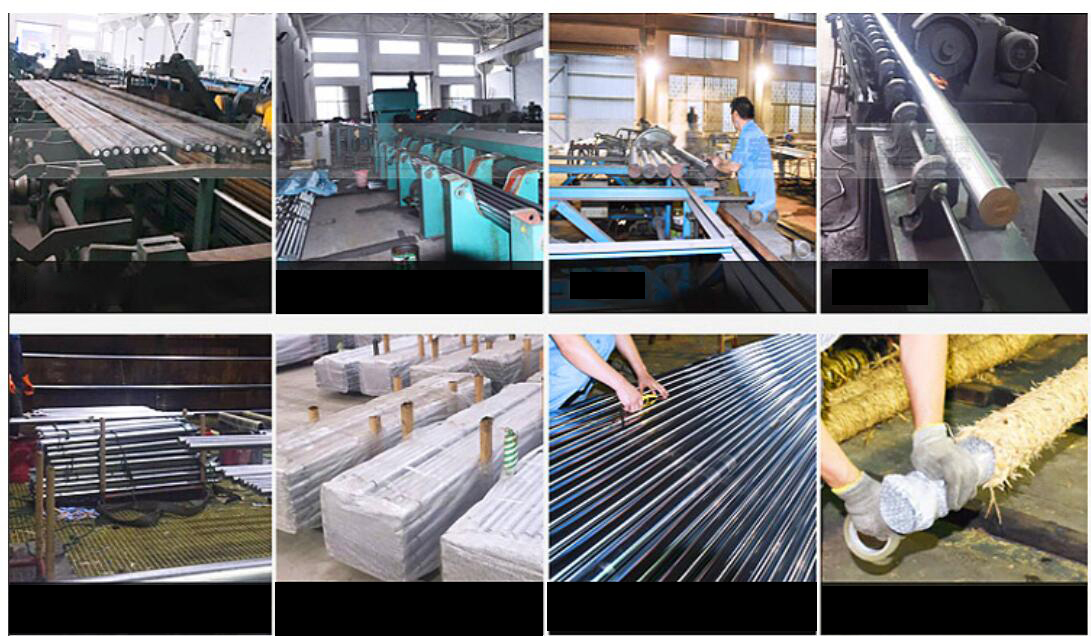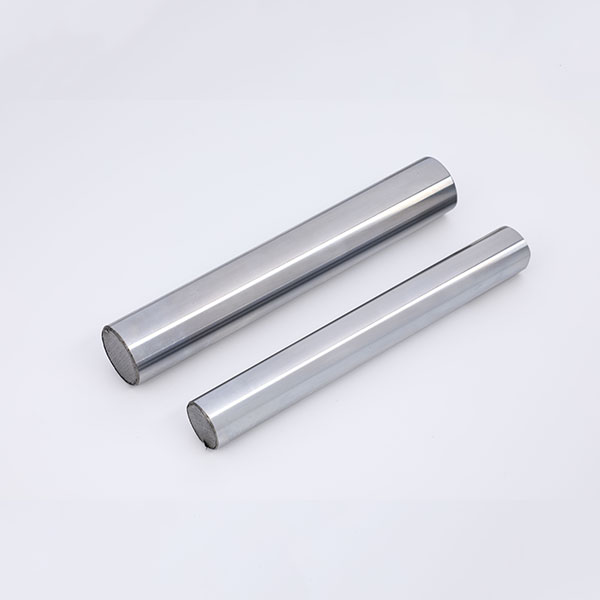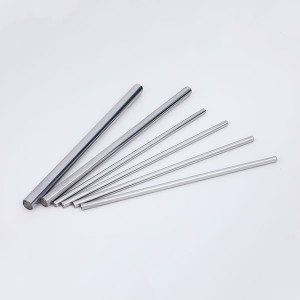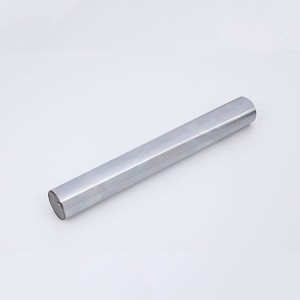High reputation Small Stainless Steel Rods - S45C Hard Chrome Plated Piston Rod For Pneumatic Cylinders – Autoair
High reputation Small Stainless Steel Rods - S45C Hard Chrome Plated Piston Rod For Pneumatic Cylinders – Autoair Detail:
The pneumatic cylinder hydraulic piston rod is also called a chrome-plated rod. It is a rod with a surface treated by special grinding and hard chrome plating. It is widely used in various cylinders, hydraulic cylinders, packaging, woodworking, spinning, printing and dyeing machines, die-casting parts and other automatic transmission devices because of its hardness, which can extend the service life of ordinary precision machinery and equipment.
We adopted the precision cold drawn, honing and polishing to manufacture the pneumatic cylinder hydraulic piston rod, every technical target meets the national standard.
Detail Specification
Materials:CK45(GB/T699-1999)
Mechanical specification:
Tensile strength(Mpa):≥600N/mm2
0,2 Yield Stress(Mpa):≥355N/mm2
Elongation:min.16%
Chrome Plated Thickness:φ<20mm≥15μm,fromφ20mm>20μm
Roughness: Ra<0.2
Hardness Chrome Layer:850HV-1050HV
Diameter Tolerance: f7,f8
Straightness: <0.1um/1000mm
Ovality:<1/2 diameter tolerance
Evaluation Corroseston Test:ISO 10289:1999,IDT
Outer diameter:3-120mm (GCr15) 3-40m(SUS440C)
Condition of delivery:Normal,Induction Harden,Q+T
Chemical composition table
| CHEMICAL COMPOSITION(%) | |||||||
| Material | C% | Mn% | Si% | S% | P% | V% | Cr% |
| <= | |||||||
| CK45 | 0.42-0.50 | 0.50-0.80 | 0.17-0.37 | 0.035 | 0.035 | ||
| ST52 | <=0.22 | <=1.6 | <=0.55 | 0.035 | 0.035 | 0.10-0.20 | |
| 20MnV6 | 0.16-0.22 | 1.30-1.70 | 0.1-0.50 | 0.035 | 0.035 | ||
| 42CrMo4 | 0.38-0.45 | 0.60-0.90 | 0.15-0.40 | 0.03 | 0.03 | 0.90-1.20 | |
| 4140 | 0.38-0.43 | 0.75-1.0 | 0.15-0.35 | 0.04 | 0.04 | 0.80-1.10 | |
| 40Cr | 0.37-0.45 | 0.50-0.80 | 0.17-0.37 | 0.80-1.10 | |||
| Diameter | Weight | Tolerance | Tolerance | Tolerance |
| mm | Kg/m | f7(μm) | f8(μm) | h6(μm) |
| 6 | 0.22 | -10–22 | -10–28 | 0–9 |
| 8 | 0.39 | -13–28 | -13–35 | 0–9 |
| 10 | 0.62 | -13–28 | -13–35 | 0–11 |
| 12 | 0.89 | -16–34 | -16–43 | 0–11 |
| 16 | 1.58 | -16–34 | -16–43 | 0–11 |
| 18 | 2.00 | -16–34 | -16–43 | 0–13 |
| 20 | 2.47 | -20–41 | -20–53 | 0–13 |
| 22 | 2.99 | -20–41 | -20–53 | 0–13 |
| 25 | 3.86 | -20–41 | -20–53 | 0–13 |
| 28 | 4.84 | -20–41 | -20–53 | 0–13 |
| 30 | 5.55 | -20–41 | -20–53 | 0–16 |
| 32 | 6.32 | -25–50 | -25–64 | 0–16 |
| 36 | 8.00 | -25–50 | -25–64 | 0–16 |
| 38 | 8.91 | -25–50 | -25–64 | 0–16 |
| 40 | 9.87 | -25–50 | -25–64 | 0–16 |
| 45 | 12.49 | -25–50 | -25–64 | 0–16 |
| 50 | 14.22 | -25–50 | -25–64 | 0–19 |
| 55 | 15.43 | -30–60 | -30–76 | 0–19 |
| 60 | 18.66 | -30–60 | -30–76 | 0–19 |
| 65 | 26.07 | -30–60 | -30–76 | 0–19 |
| 70 | 30.23 | -30–60 | -30–76 | 0–19 |
| 75 | 34.71 | -30–60 | -30–76 | 0–19 |
| 80 | 39.49 | -30–60 | -30–76 | 0–22 |
| 85 | 44.58 | -36–71 | -36–90 | 0–22 |
| 90 | 49.98 | -36–71 | -36–90 | 0–22 |
| 95 | 55.68 | -36–71 | -36–90 | 0–22 |
| 100 | 61.70 | -36–71 | -36–90 | 0–22 |
What are f7 and f8 tolerance standards:
The tolerance range of f8 is larger than that of f7, and the installation depends on the matching hole tolerance zone level. For example, when the basic size is 10-18, f8(-0.016,-0.034), f7(-0.016,-0.027), the deviation of the two tolerances is the same, the range of f7 is smaller, and the clearance range of the installation fit is smaller.
Production Flow
1 Step: Peeling/Cold Drawn:
Cold drawing is a processing technology of pneumatic cylinder piston rod. For pneumatic cylinder hard chrome plated rod, cold drawing refers to drawing under the condition of normal temperature in order to achieve a certain shape and certain mechanical properties. Compared with hot forming, cold drawn products have the advantages of higher dimensional accuracy and better surface finish.
2 Step: Straighting
This step we can make sure the hard chrome plated rod is straight enough. It’s very important, when install it insider the pneumatic cylinder. Standard straightness is 0.2mm/m.
3 Step: Honing
Honing processing is an efficient processing method that enables the pneumatic cylinder piston rod surface to achieve high precision, high surface quality and long life. It can effectively improve the dimensional accuracy, shape accuracy and reduce the Ra value, but it cannot improve the position of the hole and other surfaces.
4 Step: Steel rod Polishing
Polishing refers to the use of mechanical, chemical or electrochemical effects to reduce the surface roughness of the pneumatic cylinder piston rod to obtain a bright and smooth surface. It is the use of polishing tools and abrasive particles or other polishing media to modify the surface of the pneumatic cylinder piston rod
5 Step: Chrome Plating
Chrome plating refers to the act of plating chromium as a coating on a pneumatic hard chrome plated rod.
The chromium-plated layer has a very high hardness, and its hardness can vary within a wide range of 400-1200HV according to the composition of the plating solution and process conditions. The chrome-plated layer has good heat resistance. When heated below 500℃, there is no obvious change in gloss and hardness. The temperature will start to oxidize and change color when the temperature is above 500℃, and the hardness will decrease when it is above 700℃. The friction coefficient of the chrome layer is small, especially the dry friction coefficient, which is the lowest among all metals. Therefore, the chrome-plated layer has good wear resistance.
The chromium plating layer has good chemical stability. It has no effect in alkali, sulfide, nitric acid and most organic acids, but it can be dissolved in pneumatic acid (such as pneumatic acid) and hot sulfuric acid. In the visible light range, the reflectivity of chromium is about 65%, which is between silver (88%) and nickel (55%). Because chromium does not change color, it can maintain its reflectivity for a long time and is better than silver and nickel.
6 Step: Chrome plated rod Polishing after plating
Electroplating and polishing: are two different methods for surface treatment of metals and other materials. The former is chemical treatment, and the latter is mechanical treatment.
Electroplating: The process of using electrolysis to attach a layer of metal film to the surface of a metal or other material. It can prevent corrosion, improve wear resistance, electrical conductivity, reflectivity and enhance aesthetics.
Polishing: Use flexible polishing tools and abrasive particles or other polishing media to modify the surface of the workpiece. Polishing cannot improve the dimensional accuracy or geometric accuracy of the workpiece, but aims to obtain a smooth surface or mirror gloss.
7 Step: Chrome plated rod Quality Testing
Piston rods that have undergone electroplating and polishing processes are often accompanied by coating defects such as chrome pits and pitting. The size and quantity of these defects directly affect the performance of the piston rod. To reduce the impact of these defects on the piston rod, on the one hand, by improving the quality of raw materials, improving the processing technology, and reducing the occurrence of defects; on the other hand, it is necessary to accurately detect plating defects after the polishing process to avoid unqualified products from leaving the factory. Autoair’s engineers realize automatic defect detection with the help of image science knowledge
8 Step: Packing

FAQ:
Q1:What is a pneumatic cylinder piston rod?
A:The piston rod is a fundamental and critical component of every hydraulic or pneumatic cylinder. The piston rod typically is a precision machined length of hard chrome plated cold finished steel bar which transmits the force created by the piston to the machine component doing the work.
Q2:What is the principle of pneumatic cylinder piston rod?
A:The pneumatic cylinder piston in the cylinder bears the thrust or pull force generated by the air pressure, and directly acts on the pneumatic cylinder piston rod connected with the piston, and then the pneumatic cylinder piston rod is connected to the load workpiece to move back and forth.
Q3:What is the raw material of your pneumatic cylinder piston rod
A:Usually, the pneumatic cylinder piston rod of the pneumatic cylinder will choose 45# steel as the raw material. If the produced cylinder needs to be used in a special environment,304 stainless steel can also be used
Q4:Why choose 45# steel as raw material
A:45# steel is a high-quality carbon structural steel with low hardness and easy cutting. After quenching, its surface hardness can reach 45-52HRC. And it can also have better cutting performance and higher strength, toughness and other comprehensive mechanical properties, so it is one of the commonly used materials for shaft parts.
Q5:What is the machining process of your pneumatic cylinder piston rod?
A:In order to obtain a stable machining quality, manual straightening of the piston rod is not allowed after the machining starts. Therefore, the straightening process should be carried out before machining. Due to the poor rigidity of the workpiece, rough turning and fine turning must be carried out during the machining process to improve the machining accuracy. The working mode of the piston rod is reciprocating linear motion. In order to improve the service life of the piston rod, the surface should be chrome-plated to improve its surface hardness and wear resistance. After chrome plating, polishing treatment is required to obtain higher surface roughness, reduce friction factor, and improve sealing performance. Since the polishing process has almost no effect on the outer diameter of the piston rod, the workpiece needs to achieve a higher surface roughness before chrome plating. Therefore, it is necessary to add a fine grinding process before the chrome plating process (precision grinding can also improve the surface adhesion of chromium. ). Based on the above analysis, the more reasonable processing procedures for the piston rod are: straightening-rough turning-fine turning-fine grinding-chrome plating-polishing.
Q6:What is the polishing of pneumatic cylinder piston rod
A:During the turning process, the center hole that plays a role of positioning will show a certain degree of wear. In order to ensure the unified principle of benchmarks, the center hole should be trimmed before grinding to ensure the processing quality. When grinding, test grinding should be carried out at the outer circle near the end first, and the grinding of the piston rod can be carried out only when the runout condition meets the processing requirements. In addition to improving the dimensional accuracy, the fine grinding process also needs to obtain a higher surface roughness on the machined surface to improve the affinity of chromium ions during the electroplating process. In order to ensure that the thickness of the chromium plating layer of the final piston rod is uniform, the surface roughness after fine grinding should be close to the surface roughness after chromium plating and polishing. If the surface roughness of the piston rod is required to be high, such as Ra <0.2 μm, it should be finely ground. Add super fine grinding or polishing process after grinding.
Product detail pictures:


Related Product Guide:
We usually think and practice corresponding for the change of circumstance, and grow up. We aim at the achievement of a richer mind and body as well as the living for High reputation Small Stainless Steel Rods - S45C Hard Chrome Plated Piston Rod For Pneumatic Cylinders – Autoair , The product will supply to all over the world, such as: Iraq, venezuela, Greece, We hope we can establish long-term cooperation with all of the customers, and hope we can improve competitiveness and achieve the win-win situation together with the customers. We sincerely welcome the customers from all over the world to contact us for anything you need to have!Welcome all customers both at home and abroad to visit our factory. We hope to have win-win business relationships with you, and create a better tomorrow.
This supplier stick to the principle of "Quality first, Honesty as base", it is absolutely to be trust.






